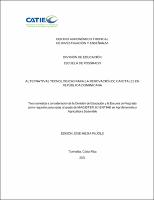Mostrar el registro sencillo del ítem
Alternativas tecnológicas para la renovación de cafetales en República Dominicana
| dc.contributor.advisor | Peguero Pérez, Felipe | |
| dc.contributor.author | Mejía Pujols, Edison | |
| dc.contributor.other | CATIE - Centro Agronómico Tropical de Investigación y Enseñanza | |
| dc.coverage.spatial | Turrialba, Costa Rica | |
| dc.date.accessioned | 2022-02-04T18:15:37Z | |
| dc.date.available | 2022-02-04T18:15:37Z | |
| dc.date.issued | 2021-12 | |
| dc.identifier.uri | https://repositorio.catie.ac.cr/handle/11554/11588 | |
| dc.description | Tesis (Mag.Sc.) –CATIE, Turrialba (Costa Rica), 2021 | es_ES |
| dc.description.abstract | Es indispensable caracterizar los cafetales de pequeños productores del país, con énfasis en los productos agrícolas que son destinados para la venta, de los árboles de servicio y maderables que interactúan con el café, así como de las labores de manejo de estos. Se identificaron los factores socioeconómicos y productivos que influyen en la decisión de renovar los cafetales, y finalmente, se evaluaron alternativas de renovación de cafetales (a los cuántos años en promedio los productores desean renovar sus cafetales), por lo que este estudio brinda elementos técnicos y científicos a los decisores del sector cafetalero dominicano sobre la renovación de cafetales. Los resultados de este estudio se obtuvieron a través del análisis de una base de datos de 400 cafetales, construida bajo el financiamiento del FONDOCyT, dirigida por investigadores del CATIE, y levantada por los técnicos del CODOCAFE. Las variables que más influyen en la decisión de renovar son la edad del cafetal y el problema de la roya. Sobre las alternativas de renovación se identificó que el momento óptimo para empezar a renovar el café es el año 9 y 10, dependiendo de si la renovación es completa o parcial. Finalmente, se constató que la renovación de tejido parcial durante 3 y 4 años genera ingresos más estables para el pequeño productor, aunque la alternativa financiera de renovar en dos años genera mayor desempeño financiero (RD $513,303/ha). | es_ES |
| dc.description.abstract | It is essential to characterize the coffee plantations of small producers in the country, with emphasis on the agricultural products that are destined for sale and the service and timber trees that interact with the coffee, as well as the management tasks of these. The socioeconomic and productive factors that influence the decision to renew the coffee plantations were identified, and finally, alternatives for the renewal of coffee plantations were evaluated, so this the study provides technical and scientific elements to the decisionmakers of the Dominican coffee sector on the renewal of coffee plantations. The results of this study were obtained through the analysis o f a database of 400 coffee plantations, built under the funding of FONDOCyT, directed by CATIE researchers, and created by CODOCAFE technicians. It was determined that the coffee industry has a significant number of women since 14% of the coffee plantation owners are women. It was identified that 75% of the producers would like to renew their coffee plantations. The variables that most influence the decision to renew are the age of the coffee plantation and the problem of rust. Regarding the renovation alternatives, it was identified that the optimal time to start renovating the cafe is the year 9 and 10, depending on whether the renovation is complete or partial. Finally, it was found that the partial tissue renewal for 3 and 4 years generates more stable income for the small producer, although the financial alternative of renewing in two years generates a higher financial performance (RD $ 513,303 / ha). | |
| dc.format.extent | 126 páginas | es_ES |
| dc.language.iso | es | es_ES |
| dc.publisher | Centro Agronómico Tropical de Investigación y Enseñanza (CATIE) | es_ES |
| dc.subject | RENOVACION DE CAFETALES | |
| dc.subject | PODA | |
| dc.subject | PRODUCTION | |
| dc.subject | AGRICULTURAL ECONOMICS | |
| dc.subject | PRODUCTIVITY | |
| dc.subject | CROP YIELD | |
| dc.subject | PRUNING | |
| dc.subject | PRODUCCIÓNHEMILEIA VASTARIX | |
| dc.subject | COFFEA | |
| dc.subject | HEMILEIA VASTARIX | |
| dc.subject | ECONOMÍA AGRÍCOLA | |
| dc.subject | TECNOLOGÍA DE PRODUCCIÓN | |
| dc.subject | PRODUCTIVIDAD | |
| dc.subject | RENDIMIENTO DE CULTIVOS | |
| dc.subject | CULTIVOS COMERCIALES | |
| dc.subject | COSECHA MANUAL | |
| dc.subject | REPÚBLICA DOMINICANA | |
| dc.subject.other | Sede Central | es_ES |
| dc.title | Alternativas tecnológicas para la renovación de cafetales en República Dominicana | es_ES |
| dc.type | Tesis | es_ES |
| dc.status | info:eu-repo/semantics/openAccess | |
| dc.identifier.status | openAccess | es_ES |
| dc.subject.sdg | ODS 12 - Producción y consumo responsables | es_ES |
Ficheros en el ítem
Este ítem aparece en la(s) siguiente(s) colección(ones)
-
Tesis [3073]


